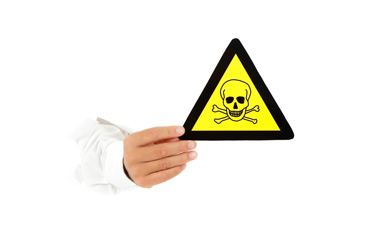
Your home could be hazardous to your health. The most innocent products can be harmful to both people and pets. You can easily eliminate most of them from your home, and find eco-friendly, healthy alternatives. Here are ten to watch out for and replace if and when you can.
1. Cleaning products. Sometimes we need a cleaner that packs a punch but most household tasks can be handled with eco-friendly alternatives. Strong chemicals in cleaners can cause respiratory problems in sensitive people and babies. Look for green cleaners or make your own.
2. Plastic bottles. They may be everywhere, and very useful, but polycarbonate plastic bottles are made with bisphenol-a (BPA) and contain phthalates to make them more durable and flexible. BPA is implicated in hormone disruption, and phthalates have been linked to developmental and reproductive problems. Choose baby bottles especially carefully.
3. Carpets. Synthetic ones give off a host of noxious volatile organic compounds (VOCs), including potentially toxic dyes. Go for eco-friendly fiber or cotton rugs, or carpets of wool. They feel good and look better too.
4. Teflon coated cookware. Teflon pots and pans are safe at low temperatures but go above that and they release toxic fumes that are damaging to humans and fatal to birds. It’s easy to overheat them, so play safe with regular pans.
5. Pressed wood products. Chipboard and similar man-made woods are processed with heavy duty glues that give off volatile and toxic gases. Use real wood or if that’s unavoidable, make sure they are properly sealed.
6. Paints. The solvents in oil and acrylic paints also emit VOCs, sometimes for years. Water-based paints are the way to go for non-toxic interiors, and are more eco-friendly too.
7. Things treated with fire retardants. Carpets and rugs, a variety of soft furnishings and various electronic items are conventionally treated with fire retardants. These chemical treatments use PBDEs (polybrominated diphenyl ethers) that have been linked to reproductive problems, thyroid dysfunction and cognitive problems, and accumulate in breast milk. They’re even used on baby bedding – use cotton instead.
8. Air fresheners. In a clean, green home air fresheners aren’t necessary – but the real reason to avoid them is that they give off phthalates, VOCs like acetone and known carcinogens and neurotoxins.
9. Pesticides. Pretty much anything that kills bugs in your home and garden is not going to be good for you. Even if it’s only mildly toxic for you, it could kill your kids and pets. There are organophosphate- and toxin-free pest repellents available and gadgets for the humane removal of insects from inside your home.
10. Asbestos. You shouldn’t have this in your home or household products because its toxic effects, particularly as a cause of the cancer mesothelioma, are well known, and it’s illegal. If you live in an older home look out for it in heating and insulation systems and if it’s there get professionals to remove it.
When you replace toxic goods in your home, get rid of the old ones appropriately. Never tip liquids down the sink or toilet. Local authorities are geared to deal with them if you’re going green and have done a swoop on toxic products in your home.

